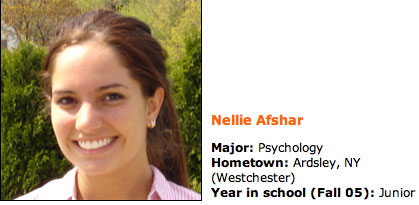March 3, 2006

SUNY Students Learn Real Life Lessons as Katrina Volunteers
Janet R. Brooks
Special to RedCross.org
Tuesday, February 28, 2006 — NEW ORLEANS – Last semester, they studied textbook disasters. Over their winter break, they helped feed and comfort disaster victims.
Five psychology students from the State University of New York at New Paltz recently spent two weeks working as American Red Cross volunteers with the Hurricane Katrina relief effort in New Orleans.
Each day, Nellie Afshar, Jemma Binder, Dawn Birk, Zachary Joyce and graduate student Jessica Walsh rose before dawn, helped load supplies, spent all day dispensing hot meals in flood-ravaged areas, and then pitched in to clean their vehicles afterward.
Their service fulfilled a field work requirement for a disaster studies practicum, part of SUNY’s new disaster studies minor, but the experience was more than that for these students.
“You couldn’t get me up at 6 a.m. for any other reason,” said Joyce, 21. “I wouldn’t get up at 6 a.m. to make money. This is the best work I’ve ever done.”
The students’ professor, James Halpern, founded SUNY’s Institute for Disaster Mental Health to prepare psychology students and others in the helping professions to care for people after disasters.
The disaster studies minor, first offered in September 2004, was designed to mix real-world experience with traditional book learning. Halpern hoped his students could serve on national disasters for the field work component of a semester-long practicum but knew that timing the stints to fit the academic year would be difficult.
“I was expecting they would be doing local field work this spring, but I’d always hoped we could figure out a way they could work on a national disaster,” said Halpern, whose textbook, “Disaster Mental Health: Theory and Practice,” will be published in June.
The months-long Red Cross relief operation in New Orleans provided the perfect opportunity. All five students took Red Cross training to prepare for their New Orleans service, but nothing could prepare them for the wide-spread physical destruction they witnessed as they delivered food and water in the city and its surrounding parishes.
Walsh tried to capture the devastation in her journal, writing: “Homes abandoned. Water lines. Warped furniture. Piles of Sheetrock. Black mold. Blue-tarped roofs. Tent cities. Cars lining the streets. Desolation. Apocalyptic. Ghost towns. Lost souls. Faith enduring.”
They had learned in class that acts of kindness can help disaster victims to recover from trauma. In the tradition of Red Cross disaster services, the students always offered warmth and empathy along with the food they handed out.
Amid the devastation, they sometimes had to force back their own tears and consciously put smiles on their faces. Often people told them that, if not for the Red Cross, they wouldn’t have eaten that day.
All were struck by the resilience of those who had lost so much. The experience made Afshar more grateful for life’s small blessings and reminded her not to take anything for granted.
“Sometimes we overlook all we have and how easily it can be taken away,” she said.
Mostly, they don’t want people to forget about those who survived Hurricane Katrina and are struggling to rebuild their homes and their lives.
“The disaster is not gone,” Birk wrote in a dispatch from New Orleans to the Hudson Valley Times Herald-Record. “It is not all rainbows and butterflies. There are people suffering all over New Orleans and they still need our help.”
Janet Rae Brooks is an American Red Cross writer deployed to Louisiana.
Sent by DN Rahni
*
*
Who's your Iranian of the day? Send
us photo
|